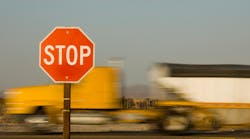Preventing a wheel separation from the tractor, trailer or coach is a very good reason to pay close attention to bearing adjustment on wheel ends. Improvements in vehicle performance, along with operating and maintenance cost savings, can also be had by properly assembling and maintaining wheel ends.
But do endplay settings on the bearings deliver satisfactory results? The answer may be: "No."
Wheel end tapered roller bearings are designed to be set to preload. They are not designed to be "loose" or have endplay.
In a preload condition, all clearances (endplay) between components in the wheel end assembly are completely eliminated and the bearings are slightly compressed. Keeping a light preload force on the bearings keeps the tapered rollers lined up so they roll the way they should.
The rest of the wheel end components including seals, tires and brakes, are designed to work best under these preloaded bearing settings.
In the past, bearing companies took the position that even though light preload is the optimal setting, there was no reliable way to measure and control preload settings in wheel bearings. For example, the Timken Company - a leading global manufacturer of highly engineered bearings, alloy steels and related components and assemblies, in its Tech Tips Volume 6, Issue 3, written in 2001, pointed out: "Unfortunately, neither dial indicators nor any other standard tool will tell a technician the amount of preload in the wheel end. . . . To date, there isn't anything available that will confirm that the fastener is providing the correct preload setting."
Tools now are readily available to adjust and verify wheel bearings to preload settings.
ACCEPTED PRACTICE
For decades, the heavy duty truck industry has accepted a recommended wheel end bearing setting of 0.001-inch to 0.005-inch of endplay. This does not mean that loose bearings equals good wheel end performance. It just means that all techniques available for wheel end bearing adjustment have the potential to achieve measurable settings somewhere in this wide endplay range.
Bearing manufacturers, along with other relevant suppliers, led the way to the Technology & Maintenance Council (TMC) establishing its Recommended Practice (RP) 618, Wheel Bearing Adjustment Procedure. Its purpose was to achieve a verifiable wheel bearing endplay 0.001-inch to 0.005-inch. More precise settings were not possible with the available technology.
When bearings are loose at any endplay setting, the rollers can go out of line and the bearings will not rotate as they should, causing a wide range of problems in the wheel end system with the bearings, seals, tires and brakes.
PRELOAD SETTINGS
When bearings are set to a measured light preload:
- Expenditures on tires are reduced because tires wear evenly and last longer.
- Seals don't leak because preload provides truer motion between the hub and spindle, subjecting the seal to less movement geometry for sealing mechanisms to follow.
- Brake systems perform as designed because vibrations are reduced.
- Risk of catastrophic failure is reduced from the consequences of misadjusted bearings.
- Unscheduled and emergency maintenance goes down, resulting in less downtime and more uptime.
"If the people that make the bearings say that preload is okay, that is good enough for me," says Greg Judy, the person in charge of maintenance for Coppercoin Transport, the delivery fleet for Fiber By-Products, a manufacturer of waste wood products. "Bearing manufacturers have published data that show optimum life of tapered roller bearings is always achieved from controlled preload settings."
"Adjustment requires hair splitting accuracy in order to optimize performance of tapered bearings and wheel ends," explains John Rode, CEO and chief engineer at Temper Axle Products Corporation. "With wheel ends, even one thousandths of an inch of endplay begins to deteriorate wheel end and vehicle performance. Preload settings deliver the best results."
FEWER ISSUES
Judy of Coppercoin says he has experienced far less wheel seal failures since using the Temper technology to adjust the wheel bearings to light preload. "If I have six technicians in the shop, they can all be trained to adjust the bearings to the same preload setting. It takes the guesswork out."
Gerry Greca, a Federal-Mogul technical specialist, says: "All components within the wheel end system benefit under controlled preload setting. To achieve controlled preload, one must follow a procedure that ensures both accurate and repeatable method. This procedure must result in an approved load range.
"Attention to accuracy, repeatability and following the proper load range specifications are key. SAE Standard J2535, Setting Preload in Heavy Duty Wheel Bearings, was created as a recommendation for an optimized load range."
"The seal has two basic functions: to keep lubricant in and contaminates out," continues Greca. "Preload provides truer motion between the hub and spindle. Better alignment gives the seal design engineer luxury in minimizing clearance and interference, resulting in better followability and less heat generation."
TIRE WEAR
Uneven tire wear plagues many fleets and owner/operators. Even with proper alignment, tire inflation and driving conditions, tires can wear prematurely and unevenly because of loose bearing settings.
Frank Evans, the owner of F & R Industries, saw his tire wear issues disappear after setting every wheel end on his tractor and trailer fleet to light preload using the latest preloading system.
"In the sand and gravel business, we are always running high weight loads and maneuvering in tight positions," he says. "Since converting our fleet to preload bearing settings, wheel ends are no longer an issue. Our tire wear problems, which were often severe, are totally gone.
"It doesn't make sense to set a wheel end to endplay," continues Evans. "Preload tools now available make everybody in the shop an expert at setting bearings because they are measuring how much preload is applied in the wheel end. It takes away the guesswork."
Guy J. Walenga, director of engineering of commercial products and technology for tire manufacturer Bridgestone Americas, confirms the results experienced at F & R Industries.
"A loose bearing at the axle end creates artificial negative camber and is a reason for premature wear on the inside shoulders of the tires," he says. "As tires become more and more finely engineered, they are more sensitive to movement in other parts on the vehicle."
VEHICLE COMPONENTS
Meritor, a leading global supplier of drivetrain, mobility, braking and aftermarket solutions for commercial vehicle and industrial markets, recognizes the importance of wheel end bearing adjustment to the performance of vehicle components well beyond the bearings themselves.
With a focus on the experiences of the industry with single wide tires, its Understanding the Impact of Wide Base Single Tires whitepaper, dated November 2011, suggests that the wheel end loses 10 percent of its life for every 0.001-inch of endplay. So, a wheel end set at 0.004-inch endplay, still within TMC RP 618's range of 0.001-inch to 0.005-inch endplay, would last 40 percent less than a bearing set to the zero point (no endplay or preload).
When preloading tools are used, the results are even better for increasing tire and wheel life.
COST SAVINGS
Properly adjusting wheel end bearings to light preload can save hundreds and even thousands of dollars on every wheel when compared to wheel ends that are in endplay.
A single wheel end can be set to light preload at an incremental cost of around $20. This investment is recouped very quickly with cost savings when tires wear evenly, seals remain intact, fuel efficiencies occur, brake systems operate correctly and bearings gain operating life.
Fleet maintenance shops and truck service centers aren't the only ones on the path to adopting preload settings for wheel end bearings.
Axles for original equipment tractors, trailers and coaches are "dressed" with wheel ends at one of several points as they are made. Manufacturers of axles, suspensions, chassis and final equipment all have production areas to assemble wheel ends.
With few exceptions, these manufacturers set wheel end bearings to the 0.001-inch to 0.005-inch endplay range using older torque-based technology. As a result, the high variability of endplay settings can lead to poor wheel end performance built into many new vehicles.
Temper Axle's Rode notes that this is changing fast, as a number of major players up and down the commercial vehicle OE supply chain are working to equip their wheel end production lines with preload adjustment technology to deliver the best performing wheel ends possible.



